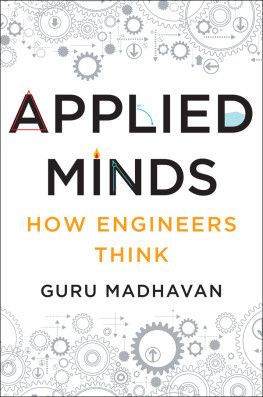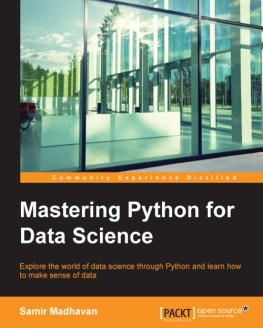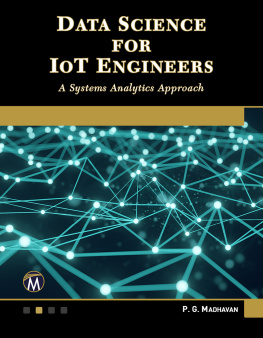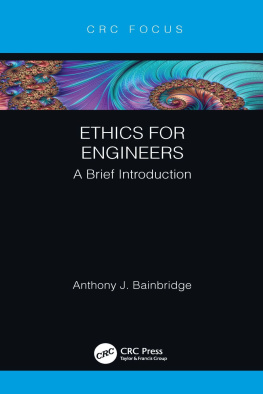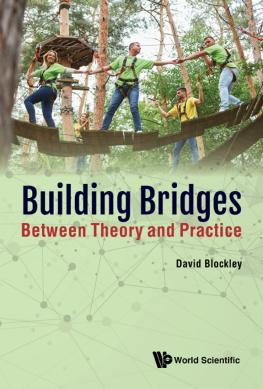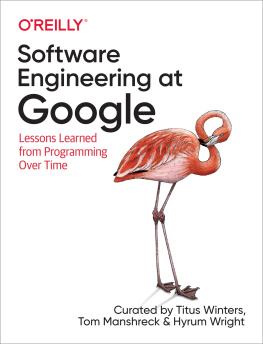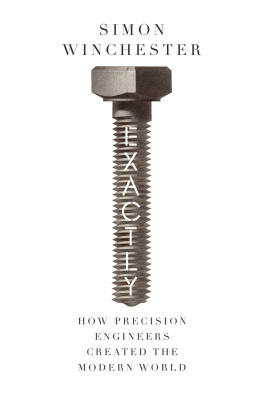
Further Praise for Applied Minds
Applied Minds will enlighten you about the minds that transform our lives. It beautifully conveys the true vision of engineering and its impact on nearly every aspect of life and global progress. This book is refreshing, most approachable, and highly recommended for anyone interested in understanding engineering.
C. D. Mote Jr., president, National Academy of Engineering
This is a delightfully interesting book and an essential treatise about ingenuity and systems thinking. Be it a mundane problem or a grand social challenge, the engineering frame of mind offers vital insights and inspiration toward better solutions.
Rita Colwell, U.S. science envoy, former director of the National Science Foundation, and National Medal of Science laureate
As a scientist, I have come to recognize the unique value that thinking like an engineer brings to almost any important endeavor. In Applied Minds , Guru Madhavan skillfully uses stories to illustrate how engineers think, while also explaining how engineering has profoundly improved our lives. Hopefully his new book will help many talented young readers become excited about engineering as a career.
Bruce Alberts, U.S. science envoy, president emeritus of the National Academy of Sciences, editor-in-chief emeritus of Science , and National Medal of Science laureate
Applied Minds is filled with elegant and touching narratives about engineering design, but just as often about pragmatism and spotting and solving problems in daily life. Graceful, versatile, and a joy to read.
Richard Foster, director emeritus of McKinsey & Company, and author of Creative Destruction
Applied Minds is captivating, entertaining, and hugely informative. Want to better understand how and why the engineering mindset is supremely important for everything from technology to human progress? Read this excellent book.
Gordon England, former U.S. secretary of the Navy and deputy secretary of defense
Any attempt to describe how engineers think would be a daunting task, but Guru Madhavan is more than up to it in his Applied Minds . With the liberal use of excellent examples and personal reflections, he expands on the often narrow image of engineers to inspiring descriptions of the many roles played by those who translate dreams and science into humanity-serving reality.
Lt. Gen. (Ret.) Henry Hatch, former chief of engineers and commander of the U.S. Army Corps of Engineers

To my parents and grandparents, and to the late Chuck Vestwho got me started.
We taste the spices of Arabia yet never feel the scorching sun which brings them forth.
Dudley North (16021677)
APPLIED MINDS

NOBODY KNEW where she came from.
It was a celeste-blue afternoon in April 1980, and the Boston Marathon was on. The streets were flanked by scores of horse-mounted police officers and hundreds of medical responders. A small aircraft skywrote Fun and Game.
The 26-mile course featured four substantial inclines, but the killer was Heartbreak Hill. A half-mile stretch some 6 miles from the finish line, it usually ended the race for several hundred of the five-thousand-plus runners.
Around half past two, the legendary Bill Rodgers crossed the finish line first for the third straight year, at two hours and twelve minutes. Several minutes later, amid the cheering and hubbub, a young woman in her midtwenties, clad in a white-and-yellow Adidas running suit, sprinted to finish first among women at two hours and thirty-one minutes.
Her name was Rosie Ruiz.
She had set a new record for Boston, becoming the third-fastest woman in the history of marathons. The cheering continued as other lead runners trickled in. One TV journalist immediately announced the time as a new American record. An interview with Ruiz followed.
REPORTER: What was the time in your first ever marathon, and where was it?
RUIZ: It was two hours, fifty-six minutes, and thirty-three seconds in New York last year.
REPORTER: You improved from two hours and fifty-six minutes to two hours and thirty-one minutes?
RUIZ: I guess so.
REPORTER: What do you attribute that improvement in time to?
RUIZ: I dont know.
REPORTER: Have you been doing a lot of heavy intervals?
RUIZ: Someone else asked me that. Im not sure what intervals are. What are they?
REPORTER: Intervals are track workouts that are designed to make your speed improve dramatically. If you went from a 2:56 to a 2:31, one would normally expect that you do a lot of speed work. Is someone coaching you or advising you?
RUIZ: No, I advise myself.
REPORTER: It was a fantastic performance, Rosie. Congratulations. Rosie Ruiz, the mystery woman winner.
Race officials were skeptical. Ruiz didnt look tired or sweaty, nor did she possess a marathoners physique. No one had spotted her at any of the six checkpoints spread over the course. Whats more, no one could locate her on the videos at any point during the eventwatched by 1.5 million people and covered by more than six hundred reporters.
One eyewitness said, I just saw someone stumble out of the crowd in front of me, across the street just on Commonwealth Ave., probably about half a mile from the finish. She was in track clothes and wearing a number, but I thought someone had just stumbled into the race; maybe somebody who was a little crazy or something. Several others agreed.
A quick background check revealed that Ruiz was a Cuban immigrant who worked as an administrative assistant in a metal commodities firm in Manhattan. Marathon officials soon found that Ruiz had run only one other marathon beforethe 1979 New York City Marathon, a qualifying race for Boston. A news photographer later recalled that Ruiz had cheated in that marathon by taking the subway to Columbus Circle and running from there toward the finish line in Central Park.
Ruizs breathtaking 1979 fakery led to her win at the Boston Marathon, where she ran only the last mile or so. Ruiz maintained her position by looking as sincere as a nun and was ready to take a multitude of lie detector tests. After almost a weeklong investigation, the Boston Athletic Association discredited and disqualified Ruiz for cheating her way through the marathon.
She was arrested.
The Ruiz scandal provided plenty of fodder for the media. The ABC show Fridays poked fun: Officials became suspicious when she crossed the finish line of the 26.2 mile event wearing open-toed sandals and smoking a cigarette. Someone who personally knew Ruiz told the media, If you ask her to shed five tears, shell shed exactly five. Ruiz may well be an ill-famed poster child for marathon offense. As a New York Times journalist put it, Her name endures like a fragile porcelain figure that has been restored after breakage.
The Rosie Ruiz incident presented a conundrum to marathon organizers. Her cheating was obvious, but it exposed the fact that policing a race with thousands of participants is a daunting challenge. How could they prevent future frauds? Engineering provided a solution from a combination of inventions originally fashioned to address two very different issues.

IN 1959, railroad companies in the United States faced a vexing challenge. The rail system included nearly 1.6 million freight cars, and company officials needed to know the precise location of each car at midnight every day. The whereabouts of these railcars had revenue implications, but there was no way to track them. What was needed was an automated means of identifying and locating the cars.
Next page
